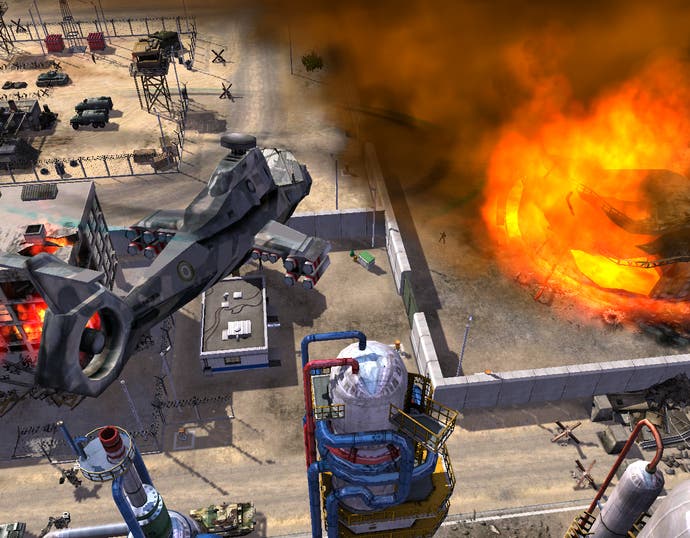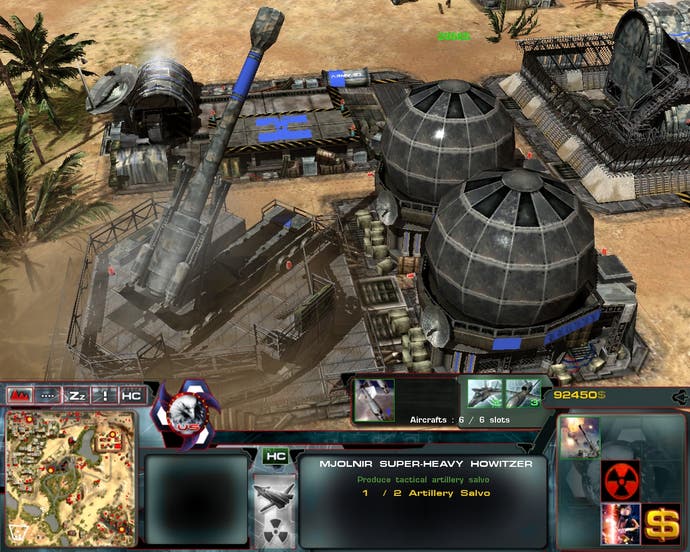Act of War: Direct Action
Like an act of Hamlet, except with less Danish folk.
Shop for games now with Simply Games.

You don’t see games that do this sort of thing anymore. That’s not saying that it’s in any way an example of visionary game design; but rather than you don’t often see high-quality examples of a game which are blatantly trying to take another’s crown. To take on another big brand-name on its own territory is something that just doesn’t happen anymore, let alone work. The last example is Call of Duty being a straight step on from Medal of Honour: Allied Assault, and usurping everyone’s affections while the original line fell into disrepute… and that had the considerable advantage of actually being done by the vast majority of the team who made Allied Assault in the first place.
So Act of War is a real surprise. Rather than attempting to create a unique-selling-point of its own, it takes another’s that has also, surprise, fallen into a sort of self-inflicted disrepute. That is, Command and Conquer – specifically, the Red Alert/Generals variety – and tries to just claim its position at the head of the table by that old-fashioned notion of simply being better. While it remains to be seen whether it manages the task, the preview build sitting on the Eurogamer hard-drive shows a drive and ambition which has long since been absent from Electronic Art’s work.
It’s a day-after-tomorrow set techno-thriller of an RTS, essentially, and in its campaign game focuses closely on the narrative elements more than most of it is genre peers in recent times. It takes its story, conceived by novelist Dale Brown, and uses every means to present it to the gamer. This means that everything from rendered footage to in-game cut-scenes to real-life filmed footage is included, with a few techniques we’ve yet to see much of before. Most noticeable is the screen-in-screen images which recall the artier 24 camera-work, where as an event/live action occurs a mini-cut-scene plays in a window while the game goes on. All are of an impressively high quality; well acted, well written and well shot.

Acted footage has been out of style for a generation of gamers but its appearance here… is surprisingly welcome. Perhaps it’s a sign of the times. Traditionally filmed footage was sneered at for breaking atmosphere in a game, as well as being terribly acted [even if it was dear old Mark Hamill doing the acting -Ed]. Going from a perfectly accurate image of a human to an eight colour sprite that looks like smeared jam isn’t very convincing. That just isn’t true anymore, as a modern RTS looks a lot more like a real environment than the games of yore.
It helps that Act of War’s environments look a lot more real than most. Cityscapes are rendered in impressively rich detail, with buildings capable of being wrecked, streets full of cars to interact with and even masses of protestors in some of the more dramatic urban moments. It’s certainly as dense an environment as an RTS has presented us, and very real. Well – at least cinematically real, as it’s a game that is in the middle of a passionate, if torrid, affair with pyrotechnic explosions. And as another airstrike’s post-white flare fills the screen, you can’t help but speculate the game’s something of a Size Queen in that department.
There’s three sides which you’re able to play in the skirmish and online mode – with two played during the campaign. These are the Consortium, the Task Force and some obscure, weirdo unit called the “US Army”. I have no idea where these game designers get their freaky ideas from. This “army” relies on the most traditional militaristic weapons, such as the ever-trusty tanks. The Task Force uses more next-generation weaponry, including exoskeletons and robot-drones, as well as a greater reliance on hit and run tactics. The Consortium is a mix between extremely high-tech equipment and cannon-fodder cheap troops. Each is strongly defined, with even basics like the construction of your base varying considerably between the three (The Army has a cheery, reliable digger. The Consortium has the greater manoeuvrability of a chopper-based constructor. The Task Force has drones which are constructed cheaply, but disappear after constructing a single installation, requiring constant replenishment).

While the whole classical Rock beats Scissors beats Curiosity kills Cat school of game design is well entrenched at this point, Act of War features a particularly brutal implementation of it. Rather than being the game where you can just about swap ability of troops in a bad situation in exchange for sheer mass of troops, this appears to be balanced to be far less forgiving to misemploying your charges. For example, helicopters are brutally efficient at destroying tanks, sweeping across the landscape leaving blackened shells vomiting clouds of smoke behind them – but hit something with any form of ground-to-air defences and expect to see your proud fleet spiralling groundwards before you blink. If you’re not paying attention, your troops can be mauled severely by the time they get home. Equally, this hard-balancing does act as a ward against simple rush play in favour of support-groups of troops, as a rush can be countered by only a relatively small number of the right troops.
In other words, at least at this stage, it’s the attention to detail which can often turn a battle, with a splash of micromanagement required to get the very best from your troops. An extreme – but characteristic - example would be my personal favourite unit, the S.H.I.E.L.D. exoskeleton soldiers. These are essentially the most generally powerful foot soldiers in the game, with the metal-frame providing greater speed, strength and resilience, as well as huge great guns strapped on the side. Imagine, if you can resist the urge to start quoting extensively from the film, a strapped-up and more nimble version of the Loader Ripley climbs into at the end of Aliens. However, their main advantage is more than their brute characteristics – rather than most troop types which are relatively limited in the units which they’re effective against, they possess both rocket launchers used to swiftly tackle vehicles and a minigun which makes fleshy filigree from most soldiers (as well as being usable, albeit less effective, against air troops).
The catch is that you have to manually switch from one mode to another at the press of a button, with a small delay as it alters. To get the highest performance from a group of them, they require nurse-maiding to make sure they have the right weapon system deployed at the right moment. Having some of them deployed in with the minigun and the other half with rockets provides a halfway measure for when you’re away, but not quite as deadly.
So: this promises to be a brutal, high gloss, high tech, state-of-the-art RTS for 2005 and certainly has the potential to achieve what it so clearly wants to do. Its weakness is simple: while it pushes the modern RTS techno-thriller approach further than anyone else has dared, will that be enough?
We’ll see soon enough with a March 18th release date confirmed.
Shop for games now with Simply Games.



.png?width=291&height=164&fit=crop&quality=80&format=jpg&auto=webp)




.jpg?width=291&height=164&fit=crop&quality=80&format=jpg&auto=webp)